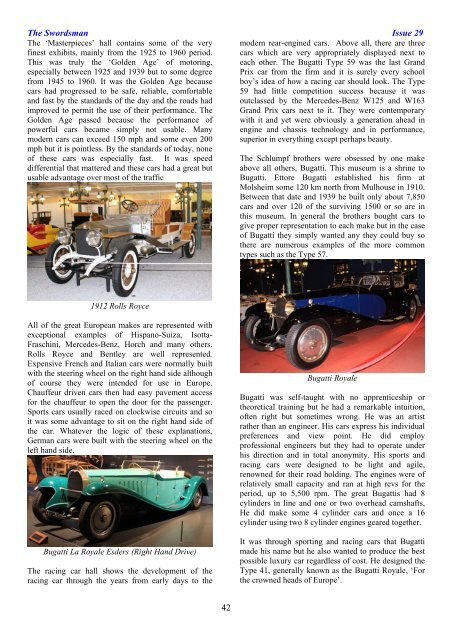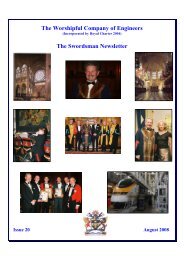The Worshipful Company of Engineers The Swordsman Newsletter ...
The Worshipful Company of Engineers The Swordsman Newsletter ...
The Worshipful Company of Engineers The Swordsman Newsletter ...
You also want an ePaper? Increase the reach of your titles
YUMPU automatically turns print PDFs into web optimized ePapers that Google loves.
<strong>The</strong> <strong>Swordsman</strong> Issue 29<br />
<strong>The</strong> ‘Masterpieces’ hall contains some <strong>of</strong> the very<br />
finest exhibits, mainly from the 1925 to 1960 period.<br />
This was truly the ‘Golden Age’ <strong>of</strong> motoring,<br />
especially between 1925 and 1939 but to some degree<br />
from 1945 to 1960. It was the Golden Age because<br />
cars had progressed to be safe, reliable, comfortable<br />
and fast by the standards <strong>of</strong> the day and the roads had<br />
improved to permit the use <strong>of</strong> their performance. <strong>The</strong><br />
Golden Age passed because the performance <strong>of</strong><br />
powerful cars became simply not usable. Many<br />
modern cars can exceed 150 mph and some even 200<br />
mph but it is pointless. By the standards <strong>of</strong> today, none<br />
<strong>of</strong> these cars was especially fast. It was speed<br />
differential that mattered and these cars had a great but<br />
usable advantage over most <strong>of</strong> the traffic<br />
1912 Rolls Royce<br />
All <strong>of</strong> the great European makes are represented with<br />
exceptional examples <strong>of</strong> Hispano-Suiza, Isotta-<br />
Fraschini, Mercedes-Benz, Horch and many others.<br />
Rolls Royce and Bentley are well represented.<br />
Expensive French and Italian cars were normally built<br />
with the steering wheel on the right hand side although<br />
<strong>of</strong> course they were intended for use in Europe.<br />
Chauffeur driven cars then had easy pavement access<br />
for the chauffeur to open the door for the passenger.<br />
Sports cars usually raced on clockwise circuits and so<br />
it was some advantage to sit on the right hand side <strong>of</strong><br />
the car. Whatever the logic <strong>of</strong> these explanations,<br />
German cars were built with the steering wheel on the<br />
left hand side.<br />
Bugatti La Royale Esders (Right Hand Drive)<br />
<strong>The</strong> racing car hall shows the development <strong>of</strong> the<br />
racing car through the years from early days to the<br />
42<br />
modern rear-engined cars. Above all, there are three<br />
cars which are very appropriately displayed next to<br />
each other. <strong>The</strong> Bugatti Type 59 was the last Grand<br />
Prix car from the firm and it is surely every school<br />
boy’s idea <strong>of</strong> how a racing car should look. <strong>The</strong> Type<br />
59 had little competition success because it was<br />
outclassed by the Mercedes-Benz W125 and W163<br />
Grand Prix cars next to it. <strong>The</strong>y were contemporary<br />
with it and yet were obviously a generation ahead in<br />
engine and chassis technology and in performance,<br />
superior in everything except perhaps beauty.<br />
<strong>The</strong> Schlumpf brothers were obsessed by one make<br />
above all others, Bugatti. This museum is a shrine to<br />
Bugatti. Ettore Bugatti established his firm at<br />
Molsheim some 120 km north from Mulhouse in 1910.<br />
Between that date and 1939 he built only about 7,850<br />
cars and over 120 <strong>of</strong> the surviving 1500 or so are in<br />
this museum. In general the brothers bought cars to<br />
give proper representation to each make but in the case<br />
<strong>of</strong> Bugatti they simply wanted any they could buy so<br />
there are numerous examples <strong>of</strong> the more common<br />
types such as the Type 57.<br />
Bugatti Royale<br />
Bugatti was self-taught with no apprenticeship or<br />
theoretical training but he had a remarkable intuition,<br />
<strong>of</strong>ten right but sometimes wrong. He was an artist<br />
rather than an engineer. His cars express his individual<br />
preferences and view point. He did employ<br />
pr<strong>of</strong>essional engineers but they had to operate under<br />
his direction and in total anonymity. His sports and<br />
racing cars were designed to be light and agile,<br />
renowned for their road holding. <strong>The</strong> engines were <strong>of</strong><br />
relatively small capacity and ran at high revs for the<br />
period, up to 5,500 rpm. <strong>The</strong> great Bugattis had 8<br />
cylinders in line and one or two overhead camshafts,<br />
He did make some 4 cylinder cars and once a 16<br />
cylinder using two 8 cylinder engines geared together.<br />
It was through sporting and racing cars that Bugatti<br />
made his name but he also wanted to produce the best<br />
possible luxury car regardless <strong>of</strong> cost. He designed the<br />
Type 41, generally known as the Bugatti Royale, ‘For<br />
the crowned heads <strong>of</strong> Europe’.




